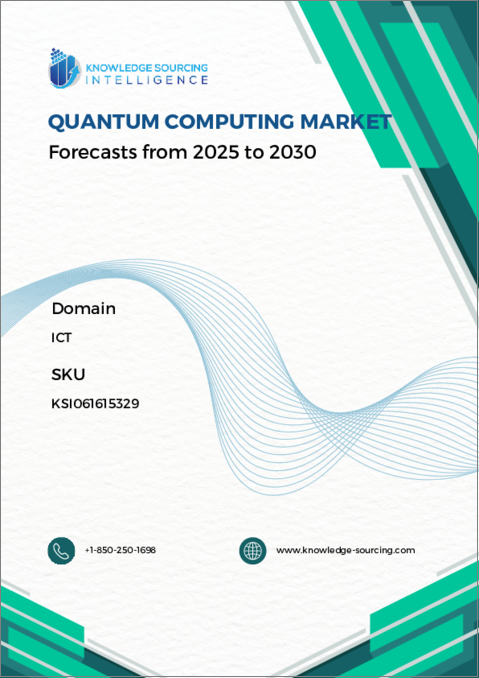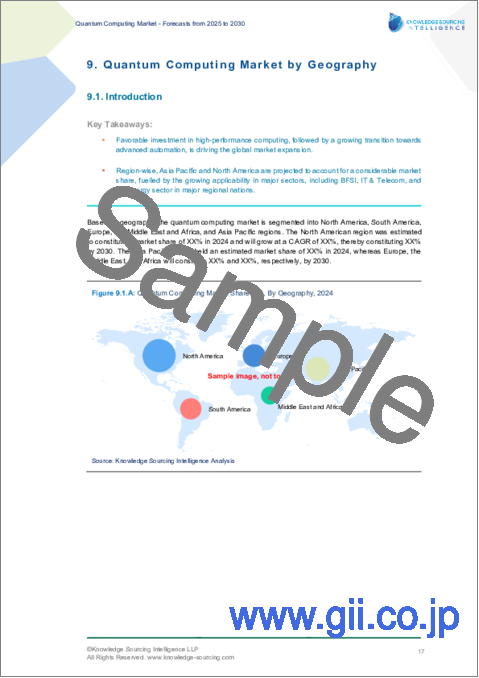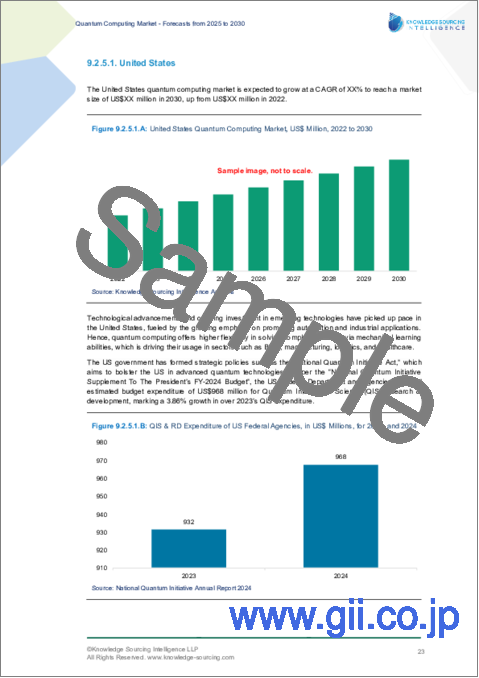|
|
市場調査レポート
商品コード
1627911
量子コンピューティング市場:予測(2025年~2030年)Quantum Computing Market - Forecasts from 2025 to 2030 |
||||||
カスタマイズ可能
|
|||||||
| 量子コンピューティング市場:予測(2025年~2030年) |
|
出版日: 2024年12月16日
発行: Knowledge Sourcing Intelligence
ページ情報: 英文 144 Pages
納期: 即日から翌営業日
|
全表示
- 概要
- 目次
量子コンピューティング市場は、2025年に17億9,324万5,000米ドルと推定され、CAGR 31.64%で成長し、2030年には70億8,813万3,000米ドルに達すると予測されています。
コンピュータサイエンスにおける量子論の応用は、量子コンピューティングとして知られています。これは、電子や光子などの素粒子を利用する考え方に関連しています。すべてが量子コンピューティングに該当します。これらの量子ビット(量子ビット)で武装すれば、粒子は一度に2つの状態で変化することができます。従来のコンピューターは、情報をビット(1と0)で表現するために、電気信号の二進法を使っています。そのため、量子コンピューティングに比べて処理できる情報量が制限されます。
さらに、量子コンピューティングは、潜在的な解決策と課題とを分離し、すべてを管理可能なパワーに還元することができます。さらに、セキュリティから銀行、軍事情報、創薬、航空機設計、ユーティリティ(核融合)、ポリマー設計、機械学習プロセスまで、多様な産業において大きな役割を担っています。暗号化された情報伝達を強化したり、レーダーによるミサイルや飛行機の認識を向上させるために使用することもできます。
また、政府が量子技術に投資し、補助金を提供したり、民間組織や企業と協力したりするなど、様々な変数により、量子コンピューティング市場は予測期間中に拡大します。さらに、大規模最適化で使用される高度な量子技術は、量子アルゴリズムのパフォーマンス結果をより高速化するために、複数のセクターでも増加しています。
市場促進要因
- デジタル化支援を目的とした政府投資と非公開会社との提携
世界各国の政府は、さまざまなビジネスに革命をもたらす可能性を秘めた量子イノベーションの重要性を認識しています。新しい装置、プログラム、アルゴリズムの改良を支援するため、量子の研究と進歩に大規模な事業が行われています。政府のイニシアティブは、進歩を促進し、革新的な行政を維持するために設定されています。政府と非公開会社のコラボレーションは、量子コンピューティング用途の改良と商業化を加速させる。政府には補助金、インフラ、専門知識が与えられ、一方、非公開会社は革新的な能力と市場情報を提供します。
さらに、政府は量子コンピューティングの技術革新に大規模な支出を行っており、これはこの技術に対する需要の高まりを反映しています。例えば、2022年11月、ドイツ航空宇宙センター(DLR)は、固体スピンを用いた量子コンピューティングの改良に関する提案を募集しました。このイニシアチブは、4年間で量子コンピュータのモデルを構築することに焦点を当てています。準備のための輸送可能なデモンストレーターを目指した第一のサブプロジェクトは、2023年までの完成を目指していました。第二のサブプロジェクトは、固体スピンに基づく量子プロセッサーのモデルを作成・構築することです。この枠組みは、いくつかの段階を経て50量子ビット以上に拡張されます。3年半にわたって行われたこのベンチャー事業は、量子イノベーションとデジタル化の進展に焦点を当てたものでした。
さらに、連邦内閣は2023年4月19日、2023-24年から2030-31年にかけて6003.65カロールルピーを投じる国家量子ミッション(NQM)の承認を発表しました。ミッションの目的は、科学的・機械的研究開発を推進し、ダイナミックな量子力学環境を作り、量子力学主導の経済開発を加速させることです。このミッションは、超伝導やフォトニック技術革新などの段階を利用し、8年以内に50~1,000量子ビットの物理的量子ビットを持つ中間スケールの量子コンピューターを作ることに焦点を当てています。
これはまた、主要な企業や組織による戦略的な協力が増えることで、より質の高いコンピューティングソリューションの開発につながる可能性もあります。その一例として、フィンランドからのハイレベルチームが2022年12月にプネーの先端コンピューティング開発センター(C-DAC)を訪問し、量子技術、HPC-量子統合、アプリケーションに関する以下のテーマセグメントで二国間協力の潜在領域と機会を探った。
本レポートを購入する理由
- 洞察に満ちた分析:主要地域だけでなく新興地域もカバーし、顧客セグメント、政府政策と社会経済要因、消費者嗜好、産業別、その他のサブセグメントに焦点を当てた詳細な市場考察を得ることができます。
- 競合情勢:世界の主要企業が採用している戦略的戦略を理解し、適切な戦略による市場浸透の可能性を理解することができます。
- 市場動向と促進要因:ダイナミックな要因と極めて重要な市場動向、そしてそれらが今後の市場展開をどのように形成していくかを探ります。
- 実行可能な提言:ダイナミックな環境の中で新たなビジネスストリームと収益を発掘するための戦略的決断を下すために、洞察を活用します。
- 幅広い利用者に対応:新興企業、研究機関、コンサルタント、中小企業、大企業にとって有益で費用対効果が高いです。
どのような用途で利用されていますか?
業界および市場考察、事業機会評価、製品需要予測、市場参入戦略、地理的拡大、設備投資の決定、規制の枠組みと影響、新製品開拓、競合の影響
調査範囲
- 2022年から2030年までの過去データおよび予測
- 成長機会、課題、サプライチェーンの展望、規制枠組み、顧客行動、およびトレンド分析
- 競合のポジショニング、戦略、および市場シェア分析
- セグメントおよび各国を含む地域の収益成長および予測分析
- 企業プロファイリング(特に主要な開発)
目次
第1章 イントロダクション
- 市場概要
- 市場の定義
- 調査範囲
- 市場セグメンテーション
- 通貨
- 前提条件
- 基準年と予測年のタイムライン
- 利害関係者にとっての主なメリット
第2章 調査手法
- 調査デザイン
- 調査プロセス
第3章 エグゼクティブサマリー
- 主な調査結果
- アナリストビュー
第4章 市場力学
- 市場促進要因
- 市場抑制要因
- ポーターのファイブフォース分析
- 業界バリューチェーン分析
第5章 量子コンピューティング市場:コンポーネント別
- イントロダクション
- ハードウェア
- ソフトウェアとサービス
第6章 量子コンピューティング市場:展開別
- イントロダクション
- オンプレミス
- クラウドベース
第7章 量子コンピューティング市場:業界別
- イントロダクション
- BFSI
- 自動車
- 製造業
- ヘルスケア
- ITおよび通信
- エネルギーと電力
- その他
第8章 量子コンピューティング市場:用途別
- イントロダクション
- 人工知能と機械学習
- 計算化学
- 医薬品の設計と開発
- サイバーセキュリティと暗号化
- 財務モデリング
- 物流最適化
- その他
第9章 量子コンピューティング市場:地域別
- イントロダクション
- 北米
- コンポーネント別
- 展開別
- 業界別
- 用途別
- 国別
- 南米
- コンポーネント別
- 展開別
- 業界別
- 用途別
- 国別
- 欧州
- コンポーネント別
- 展開別
- 業界別
- 用途別
- 国別
- 中東・アフリカ
- コンポーネント別
- 展開別
- 業界別
- 用途別
- 国別
- アジア太平洋
- コンポーネント別
- 展開別
- 業界別
- 用途別
- 国別
第10章 競合環境と分析
- 主要企業と戦略分析
- 市場シェア分析
- 合併、買収、合意およびコラボレーション
- 競合ダッシュボード
第11章 企業プロファイル
- IBM
- Microsoft
- Quantum Computing Inc.
- Intel Corporation
- D-Wave Quantum Inc.
- Quix Quantum BV
- Alpine Quantum Technologies GmbH
- ORCA Computing
- Rigetti & Co, LLC.
- Google LLC
- Nanofiber Quantum Technologies
- IQM Finland Oy
The Quantum Computing market is estimated at US$1,793.245 million in 2025 and is expected to grow at a CAGR of 31.64% to attain US$7,088.133 million by 2030.
The application of Quantum theory in computer science is known as quantum computing. It is related to the idea of using subatomic particles, such as electrons or photons. It all falls under quantum computing. Armed with these quantum bits, or qubits, the particles could vary in two states at once. Conventional computers use a binary operation of electric signals to represent information in terms of bits (1 and 0). This limits the amount of information that can be processed by them as compared to quantum computing.
Moreover, quantum computing can separate the potential solutions from the challenging problems, and reduce everything to a manageable power. Additionally, they have a major role in diverse industries from security to banking, military intelligence, drug discovery, aircraft designs, utilities (nuclear fusion), polymer design, and machine learning processes; merging artificial intelligence responding triggers big data search & digital manufacturing. They could be used to enhance encrypted information transfer or for better missile/airplane recognition by radars.
Additionally, the quantum computing market will experience expansion during the forecasted period due to various variables including the government investing in quantum technologies by providing subsidies as well as collaborating with private organizations and corporations. Additionally, the advanced quantum technologies used in large-scale optimization are also rising for multiple sectors for faster quantum algorithm performance results.
Quantum computing market drivers
- Government investments and partnerships with private companies aimed at digitization support.
Governments around the world recognize the vital significance of quantum innovation, which has the potential to revolutionize different businesses. Major ventures are being made in quantum research and advancement, supporting the improvement of new equipment, programs, and algorithms. Government initiatives have been set up to cultivate advancement and maintain innovative administration. Collaborations between governments and private companies can quicken the improvement and commercialization of quantum computing applications. Governments are given subsidizing, infrastructure, and expertise, whereas private companies contribute their innovative capabilities and market information.
Moreover, governments are spending majorly on quantum computing innovation, which reflects the growing demand for the technology. For instance, in November 2022, The German Aerospace Center (DLR) called for proposals for the improvement of quantum computing with solid-state spins. The initiative focuses on constructing models of quantum computers over four years. The primary sub-project aimed at a transportable demonstrator for preparation was aimed to be completed by 2023. The second sub-project was to create and construct a model of a quantum processor based on solid-state spins. The framework is extended to 50 qubits or more over several phases. The venture, which ran for three and a half years, focused on progressing quantum innovation and digitalization.
Additionally, the Union Cabinet announced the approval of the National Quantum Mission (NQM) on 19th April 2023, costing Rs. 6003.65 crore from 2023-24 to 2030-31. The mission objective is to propel scientific and mechanical R&D, make a dynamic QT environment, and quicken QT-led economic development. The mission focuses on creating intermediate-scale quantum computers with 50-1000 physical qubits in 8 years utilizing stages like superconducting and photonic innovation.
This could also lead to better quality computing solutions getting developed due to more strategic collaborations happening by major players and organizations. As an example of this, a high-level team from Finland visited the Centre for Development of Advanced Computing (C-DAC), Pune in December 2022 to explore potential areas and opportunities for bilateral cooperation in the following thematic segments on quantum technologies, HPC-quantum integration, and applications.
Reasons for buying this report:-
- Insightful Analysis: Gain detailed market insights covering major as well as emerging geographical regions, focusing on customer segments, government policies and socio-economic factors, consumer preferences, industry verticals, other sub- segments.
- Competitive Landscape: Understand the strategic maneuvers employed by key players globally to understand possible market penetration with the correct strategy.
- Market Drivers & Future Trends: Explore the dynamic factors and pivotal market trends and how they will shape up future market developments.
- Actionable Recommendations: Utilize the insights to exercise strategic decision to uncover new business streams and revenues in a dynamic environment.
- Caters to a Wide Audience: Beneficial and cost-effective for startups, research institutions, consultants, SMEs, and large enterprises.
What do businesses use our reports for?
Industry and Market Insights, Opportunity Assessment, Product Demand Forecasting, Market Entry Strategy, Geographical Expansion, Capital Investment Decisions, Regulatory Framework & Implications, New Product Development, Competitive Intelligence
Report Coverage:
- Historical data & forecasts from 2022 to 2030
- Growth Opportunities, Challenges, Supply Chain Outlook, Regulatory Framework, Customer Behaviour, and Trend Analysis
- Competitive Positioning, Strategies, and Market Share Analysis
- Revenue Growth and Forecast Assessment of segments and regions including countries
- Company Profiling (Strategies, Products, Financial Information, and Key Developments among others)
The Quantum computing market is segmented and analyzed as follows:
By Component
- Hardware
- Software and Service
By Deployment
- On-Premises
- Cloud-Based
By Industry Vertical
- BFSI
- Automotive
- Manufacturing
- Healthcare
- IT & Telecom
- Energy & Power
- Others
By Applications
- Artificial Intelligence & Machine Learning
- Computational Chemistry
- Drug Design & Development
- Cybersecurity & Cryptography
- Financial Modelling
- Logistics Optimisation
- Others
By Geography
- North America
- USA
- Canada
- Mexico
- South America
- Brazil
- Argentina
- Others
- Europe
- Germany
- France
- United Kingdom
- Spain
- Others
- Middle East and Africa
- Saudi Arabia
- UAE
- Others
- Asia Pacific
- China
- Japan
- India
- South Korea
- Indonesia
- Taiwan
- Others
TABLE OF CONTENTS
1. INTRODUCTION
- 1.1. Market Overview
- 1.2. Market Definition
- 1.3. Scope of the Study
- 1.4. Market Segmentation
- 1.5. Currency
- 1.6. Assumptions
- 1.7. Base and Forecast Years Timeline
- 1.8. Key Benefits for the Stakeholders
2. RESEARCH METHODOLOGY
- 2.1. Research Design
- 2.2. Research Process
3. EXECUTIVE SUMMARY
- 3.1. Key Findings
- 3.2. Analyst View
4. MARKET DYNAMICS
- 4.1. Market Drivers
- 4.2. Market Restraints
- 4.3. Porter's Five Forces Analysis
- 4.3.1. Bargaining Power of Supplier
- 4.3.2. Bargaining Power of Buyers
- 4.3.3. Threat of New Entrants
- 4.3.4. Threat of Substitutes
- 4.3.5. Competitive Rivalry in the Industry
- 4.4. Industry Value Chain Analysis
5. QUANTUM COMPUTING MARKET BY COMPONENT
- 5.1. Introduction
- 5.2. Hardware
- 5.3. Software and Service
6. QUANTUM COMPUTING MARKET BY DEPLOYMENT
- 6.1. Introduction
- 6.2. On-Premises
- 6.3. Cloud-Based
7. QUANTUM COMPUTING MARKET BY INDUSTRY VERTICAL
- 7.1. Introduction
- 7.2. BFSI
- 7.3. Automotive
- 7.4. Manufacturing
- 7.5. Healthcare
- 7.6. IT & Telecom
- 7.7. Energy & Power
- 7.8. Others
8. QUANTUM COMPUTING MARKET BY APPLICATIONS
- 8.1. Introduction
- 8.2. Artificial Intelligence & Machine Learning
- 8.3. Computational Chemistry
- 8.4. Drug Design & Development
- 8.5. Cybersecurity & Cryptography
- 8.6. Financial Modelling
- 8.7. Logistics Optimisation
- 8.8. Others
9. QUANTUM COMPUTING MARKET BY GEOGRAPHY
- 9.1. Introduction
- 9.2. North America
- 9.2.1. By Component
- 9.2.2. By Deployment
- 9.2.3. By Industry Vertical
- 9.2.4. By Application
- 9.2.5. By Country
- 9.2.5.1. USA
- 9.2.5.2. Canada
- 9.2.5.3. Mexico
- 9.3. South America
- 9.3.1. By Component
- 9.3.2. By Deployment
- 9.3.3. By Industry Vertical
- 9.3.4. By Application
- 9.3.5. By Country
- 9.3.5.1. Brazil
- 9.3.5.2. Argentina
- 9.3.5.3. Others
- 9.4. Europe
- 9.4.1. By Component
- 9.4.2. By Deployment
- 9.4.3. By Industry Vertical
- 9.4.4. By Application
- 9.4.5. By Country
- 9.4.5.1. Germany
- 9.4.5.2. France
- 9.4.5.3. United Kingdom
- 9.4.5.4. Spain
- 9.4.5.5. Others
- 9.5. Middle East and Africa
- 9.5.1. By Component
- 9.5.2. By Deployment
- 9.5.3. By Industry Vertical
- 9.5.4. By Application
- 9.5.5. By Country
- 9.5.5.1. Saudi Arabia
- 9.5.5.2. UAE
- 9.5.5.3. Others
- 9.6. Asia Pacific
- 9.6.1. By Component
- 9.6.2. By Deployment
- 9.6.3. By Industry Vertical
- 9.6.4. By Application
- 9.6.5. By Country
- 9.6.5.1. China
- 9.6.5.2. Japan
- 9.6.5.3. India
- 9.6.5.4. South Korea
- 9.6.5.5. Indonesia
- 9.6.5.6. Taiwan
- 9.6.5.7. Others
10. COMPETITIVE ENVIRONMENT AND ANALYSIS
- 10.1. Major Players and Strategy Analysis
- 10.2. Market Share Analysis
- 10.3. Mergers, Acquisitions, Agreements, and Collaborations
- 10.4. Competitive Dashboard
11. COMPANY PROFILES
- 11.1. IBM
- 11.2. Microsoft
- 11.3. Quantum Computing Inc.
- 11.4. Intel Corporation
- 11.5. D-Wave Quantum Inc.
- 11.6. Quix Quantum BV
- 11.7. Alpine Quantum Technologies GmbH
- 11.8. ORCA Computing
- 11.9. Rigetti & Co, LLC.
- 11.10. Google LLC
- 11.11. Nanofiber Quantum Technologies
- 11.12. IQM Finland Oy





